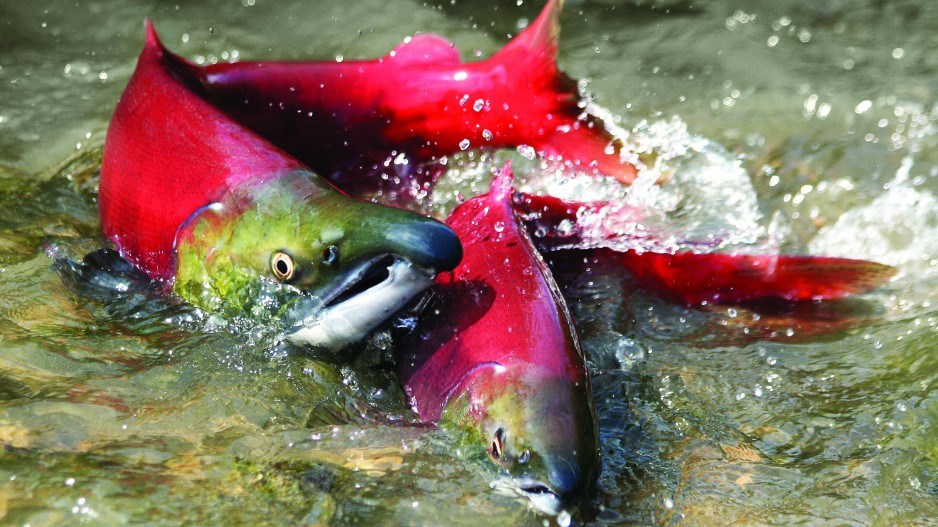When 21 million sockeye salmon return just five years after stocks crashed below two million, it’s hard to complain.
But commercial fishermen in B.C. will leave about $20 million on the table this year, according to one estimate, thanks to overly cautious escapements this year.
As this year’s Fraser River sockeye season drew to a close last week, returns were estimated at 20.8 million. That’s about seven million fewer fish than in 2010, but still a banner year, compared with most returns over the last few decades.
“It’s probably among the top five runs within the last 60 years,” said Rob Morley, vice-president of product and corporate development for the Canadian Fishing Co.
Even so, retired fisheries scientist Carl Walters estimates that Area E gillnetters could easily have been allocated an additional one million sockeye this year.
“I’m particularly upset that they haven’t allowed the gillnet fishery to take more fish,” said Walters, professor emeritus at the University of British Columbia’s Fisheries Centre. “I can see no reason whatsoever for them being as restrictive as they have on the inside fishery.”
“When they let us fish, it was good, but they wouldn’t let us fish to our allocation,” said Barry Marcotte, an Area E gillnet fisherman. “Area E and D gillnetters are both short their allocation.”
Morley said the commercial harvest of Fraser River sockeye was over eight million fish. The escapement goal is 7.3 million, according to the Department of Fisheries and Oceans (DFO).
First Nations were allocated about 1.5 million, as of September 22. Twenty-two First Nations along the Fraser River were awarded commercial licences this year for a total catch of 400,000, said Ken Malloway, chairman of the Lower Fraser Fisheries Alliance.
Malloway said his members don’t understand why First Nations in the Shuswap region got more than double that.
“There’s no way they’re ever going to catch their allocation,” he said.
Morley agreed: “It’s highly unlikely that they’ll catch any significant portion of those fish.”
He said the “low-tech dip-net” fishing techniques that First Nations in the region are limited to means they can’t possibly catch their allocation. And even if they could, the fish are so close to death’s door that they have very low commercial value.
That translates into a de facto escapement that is above what fisheries managers set for their targets.
Walters questions the DFO’s escapement policies. Of the 28 million sockeye that returned in 2010, 13 million were allowed to escape to their spawning grounds. (The sockeye that have just returned were the progeny of the 2010 sockeye, which have a four-year lifespan.)
Dumping large amounts of fish on spawning grounds does not guarantee a large return four years later, because rivers and lakes have a limited capacity to provide food for them all.
Don Noakes, former head of DFO’s Pacific Biological Station, said there can be a “negative feedback” when spawning grounds are overloaded with too many fish.
But weak stocks – like the Cultus Lake sockeye, which is classified as a species at risk – can mingle with stronger ones, and DFO allows for escapements that seem excessive to ensure an adequate return for the weakest stocks.
But, said Walters, “if that were working – if those stocks were coming back – you could say it’s a good thing for the environment. [But] they aren’t coming back. So it’s a failed policy.”
In an analysis of escapements since 1995, Walters estimates that DFO has allowed 24 million more Fraser River sockeye to return than was necessary. He estimates the economic loss of that to be between $1 billion and $2 billion.
“For this year, it looks like the economic loss will be at least an additional $20 million, just based on the stocks that have returned so far and not harvesting the ‘dead fish swimming’ that have already headed upstream to the Adams River and will die before they can spawn,” Walters said.
DFO and Pacific Salmon Commission representatives could not be reached for comment by press time. •
Sea lice theory questioned in wake of 2014 salmon run
More than a decade ago, when scientists were trying to figure out why some pink salmon runs were on the verge of collapse on the B.C. coast, a biologist studying orca whales in the Broughton Archipelago stumbled on what she thought might be the culprit.
The result, she said, is that the average infection rate in juvenile salmon in the Broughton Archipelago has dropped from nine lice per fish to one or fewer.




